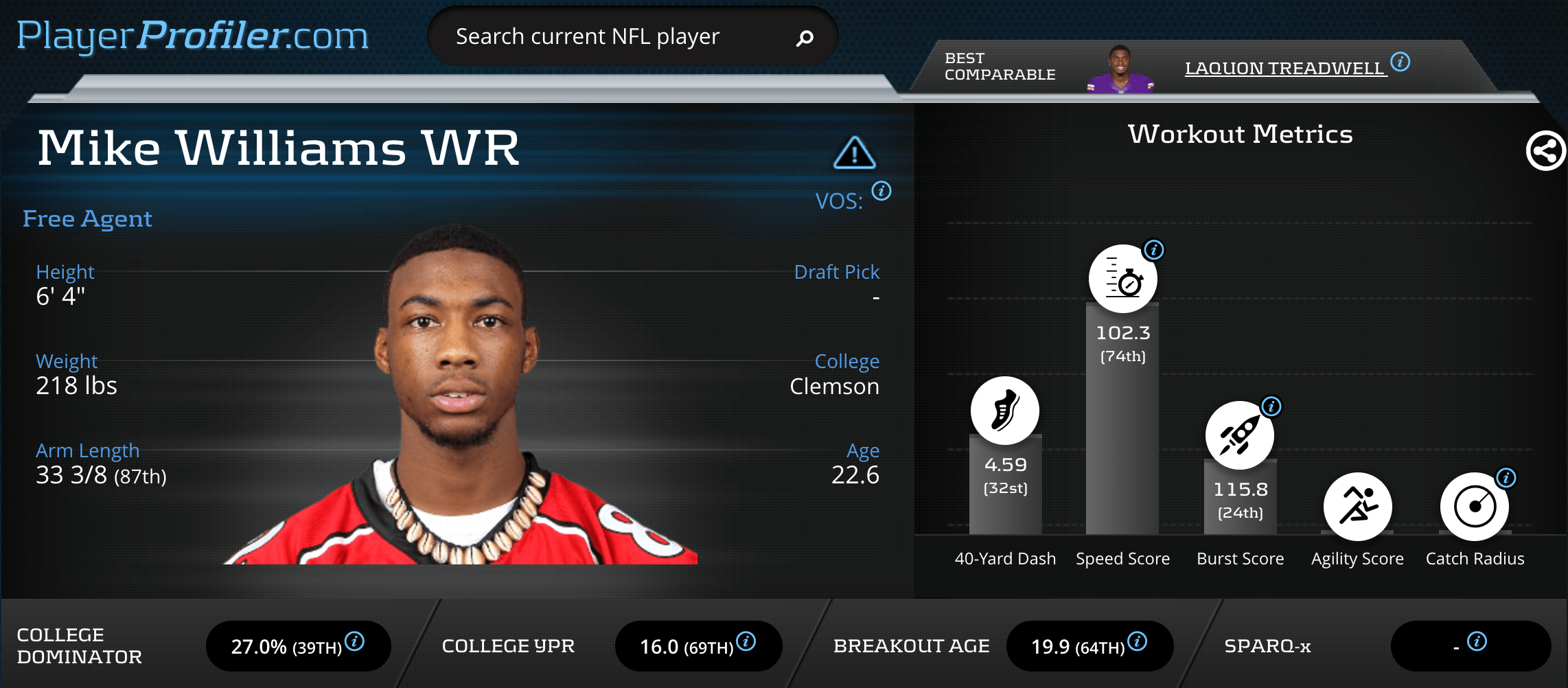Rookie Profile: Mike Williams, WR Clemson
Mike Williams is widely considered one of the two best wide receivers in the 2017 NFL draft class, and for good reason. After suffering a terrifying season-ending neck injury in the first game of the 2015 season, the 6’4” wideout is commonly thought to be among the top tier of dynasty assets in this class and most expect him to be the first receiver off the board in the NFL draft next week. What makes him so appealing?
Production
[am4show have=’g1;’ guest_error=’sub_message’ user_error=’sub_message’ ]

Statistics from Sports-Reference.com.
Williams had a ordinary freshman year in the shadow of Sammy Watkins and Martavis Bryant, catching just 20 passes for 316 yards and three touchdowns. However, Williams exploded for over 1,000 yards the following season and appeared poised to follow up on his dominance in 2015, but was derailed by the aforementioned neck injury. Saving his best for last, though, Williams returned in 2016 and posted a 98-1,361-11 line. His 1,361 receiving yards ranks third-most in a single season all-time at Clemson – a school that has churned out elite talent at the receiver position this decade. He was the clear lead dog in an offense that has plenty of other draftable pass-catching talent. How does he stack up as an athlete?
Measurables
Williams opted out of most drills at the Combine, so his Mock Draftable web is woefully incomplete. What is evident, though, is that he is a massive human. Standing at 6’4” and 218 pounds, Williams ranks in the 91st and 86th percentiles at the wide receiver position for height and weight, respectively. He extends his giant catch radius with extremely long arms (87th percentile). Unfortunately, what we were able to see of his athletic testing at the combine was mediocre at best. His vertical jump of 32 and a half inches was horrible, landing him in the 16th percentile, while his broad jump and bench press were just barely above average.
Because Williams has little athletic testing to his name, his comparisons aren’t much to go off of. Brian Quick appears on the list, but it’s Quick and then a bunch of names. Thankfully, Williams ran the 40 at his pro day, so his workout metrics, courtesy of Player Profiler, are a little more complete.

As mentioned above, we aren’t able to glean any information from his incomplete SPARQ-x, Agility Score, and Catch Radius workout metrics, although we don’t need to see a percentile on his “Catch Radius” measure to know that he’s elite in that regard. Williams’ Height-Adjusted Speed Score (HaSS) – a metric that favors taller, faster receivers – placed him in the 74th percentile. Not much else here is particularly exciting – his Pro Day 40 of 4.54 was adjusted by five seconds to 4.59 (to normalize for not participating at the Combine), subsequently landing him in the 32nd percentile. Even more abysmal was his Burst Score, which measures a player’s zero-inertia explosiveness or stop-start acceleration (24th percentile). His best comparable is Laquon Treadwell, another middling athlete with good size who wasn’t able to get on the field at all his rookie season.
It’s not all negative. Although his College Dominator rating is mediocre at 27.0 percent (39th percentile), Williams shared the field with other high-profile pass-catchers, had a quarterback who didn’t need to lock onto his top target to create plays, and coexisted with a prolific ground attack. More encouraging are his college YPR (16.0) and breakout age of 19.9, both above average marks at the position.
Fortunately, though, Williams doesn’t win with athleticism. Let’s dive into why he’s so highly regarded.
Film & Traits
Despite mediocre athleticism, Williams is an excellent deep threat. Watching him, you notice that he’s “open” even when he can’t create separation. Because he’s so big, his catch radius is large enough to bail out a quarterback’s errant throw, and he frequently boxes out smaller defensive backs downfield. He possesses the ability to pluck the ball out of the sky, dominating at the catch point with great hands and elite body control.
Williams can completely take games over. Despite Deshaun Watson’s willingness and ability to successfully spread the ball around, there were times where he would lock onto Williams for entire drives at a time and rely on him to move the chains. He’s a dependable target near the chains and in the red zone, consistently converting in crunch time. Williams does seem faster than his 40 time would indicate and is an asset after the catch, playing to the whistle and fighting for every yard on every play.
There are areas of his game that he could improve as well. Because he doesn’t create much separation, he requires a quarterback that will trust him and take chances by throwing into smaller windows. He doesn’t have much experience running the whole route tree – although you cannot fault a player for not doing something they were not asked to do – but is a better route runner than many give him credit for.
Williams has a strange tendency to leave his feet too often, which hinders him by slowing him down and making him easier to tackle. He could also use additional coaching as a blocker, as he doesn’t utilize his large frame to his advantage as frequently as he should.
Overall
As next week’s NFL Draft approaches, it’s becoming more likely that Williams will be the first wide receiver off the board. Drawing comparisons in play style to Alshon Jeffery in a league that values passing more than rushing, he may find himself climbing back up dynasty rookie draft boards sooner rather than later.
[/am4show]
- Preseason Week One Dynasty Takeaways: Part Two - August 18, 2021
- Preseason Week One Dynasty Takeaways: Part One - August 18, 2021
- 2021 Rookie Class: An Early Look at Terrace Marshall, WR LSU - January 26, 2021


































































